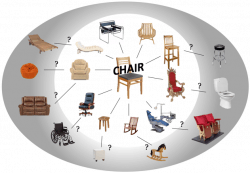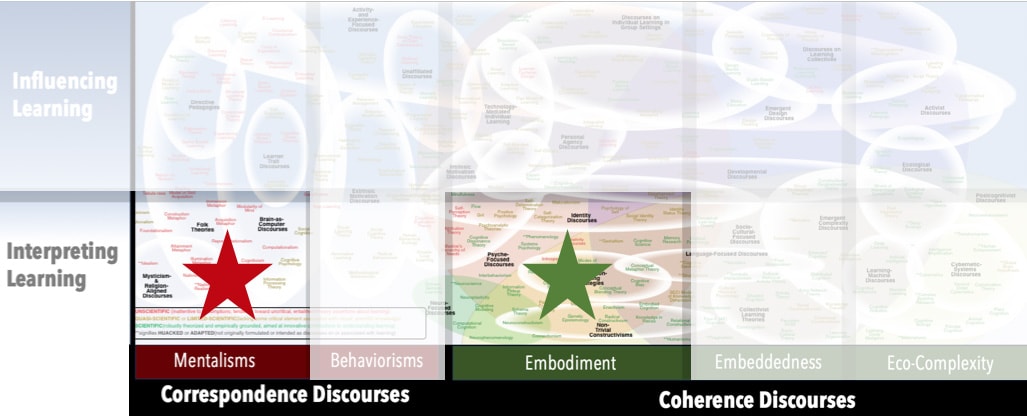Focus
Modeling a concept to understand its constituent elements, its structure, and how it developsPrincipal Metaphors
The notion of “schema” is embraced across a broad range of learning theories. In particular, it is prominently invoked in both Cognitivism and Non-Trivial Constructivisms. The latter are more prominent in the field of education – and the cluster of associated metaphors can be readily tweaked to fit with the brain-as-computer lens applied by Cognitivism and other Brain-as-Computer Discourses.- Knowledge is … already-established-but-always-evolving construals
- Knowing is … personal sense derived from individual experience
- Learner is … a meaning-maker (individual)
- Learning is … construing associations among experiences
- Teaching is … supporting sense-making
Originated
1930sSynopsis
Schema Theory describes how personal knowledge is elaborated and structured. A schema (pl. schemata) is the network of associations that constitutes a concept for someone, and learning is understood as an iterative process of revising schema to maintain coherence in the face of new experiences, information, and demands. One’s current schemata are the principal determiner of what one will learn through subsequent experiences. (The image is intended to illustrate these points for an imaginary person’s schema of “chair.” Objects in the white region will be readily integrated – i.e., assimilated – as chairs; whereas the imaginary person’s “chair” schema will require some adjustment of the current chair schema – i.e., accommodation – for the objects in the shaded region to be met as chairs.) One has many overlapping and intersecting schemata that vary in abstraction – covering, for example, words, objects, ideologies, and cultural truths.
Important constructs within Schema Theory include:
constitutes a concept for someone, and learning is understood as an iterative process of revising schema to maintain coherence in the face of new experiences, information, and demands. One’s current schemata are the principal determiner of what one will learn through subsequent experiences. (The image is intended to illustrate these points for an imaginary person’s schema of “chair.” Objects in the white region will be readily integrated – i.e., assimilated – as chairs; whereas the imaginary person’s “chair” schema will require some adjustment of the current chair schema – i.e., accommodation – for the objects in the shaded region to be met as chairs.) One has many overlapping and intersecting schemata that vary in abstraction – covering, for example, words, objects, ideologies, and cultural truths.
Important constructs within Schema Theory include:
- Percept – a conscious noticing
- Concept – an integrated network of associations, abstracted from a class of Percepts, that is useful for making sense of and acting upon that class
- Schema – the subjective network of associations that constitutes a Concept (see above) for someone
- Assimilation – applying prior learnings to new information (e.g., referring to all farm buildings as “houses”), and so learning with no modification to a schema
- Accommodation – revising prior learnings to deal with new information (e.g., upon learning that non-human animals live in barns and wheat is stored in granaries, distinguishing among “farm buildings”), and so significantly modifying a schema
- Restructuring – forming new schemata
- Tuning – modifying schemata
Within Schema Theory, individual schemata are understood to contribute to and to exist within grander, coherent systems:
- Cognitive Structure – in effect, a “meta-schema” – that is, a network of associated ideas relating to a core topic. For example, many have suggested that an issue with school mathematics is that learners often develop functional schemata for individual operations without developing an overarching schema – that is, a Cognitive Structure – to link them.
- Conceptual System – in effect, a “meta-meta-schema” – that is the assemblage of one’s Cognitive Structures (see above), one’s belief systems, one’s emotional set, and so on, into a coherence that orients one’s perceptions, frames one’s interpretations, and channels one’s actions
- Action Schema – the coherent, integrated aspects of a particular action that are structured in a manner which allows the knowing agent to repeat that action in novel contexts
- Emotional Schema – a network of emotional responses associated with particular experiences (with people, objects, events, etc.) that can be transferred onto analogous situations and agents
- Image Schema (Mark Johnson, 1980s) –associated with Conceptual Metaphor Theory, a type of Schema in which concrete bodily action serves as the source of an abstract conceptual metaphor
- Self-Schema (Phenomenal Self; Working Self-Concept) – one’s sense of one’s own abilities, willpower, and agency – typically considered against the backdrop of one’s interest and aspirations
- Social Schema – one’s sense of social norms and collective behavior within a given social group or society
- Adaptive Resonance Theory (ART) (Stephen Grossberg, Gail Carpenter. 1980s) – the suggestion that percepts and concepts emerge in the interaction of already-developed, top-down expectations and newly-experienced, bottom-up sensory information. When these resonate, percepts and concepts are consolidated. When there is dissonance, new information is either assimilated or accommodated, depending on whether it is under or over a set threshold.
- Cognitive Economy (Nicholas Rescher, 1980s) – a perspective aimed at understanding how humans apportion their finite cognitive capacities – that is, the means that enable one to focus on relevant features, while avoiding distraction of other details. The main foci of Cognitive Economy are the simplicity and relevance of one’s categories and schemata.
- Conceptual Change (Susan Carey, 1980s) –Subject to varied interpretations in the education literature, understandings of Conceptual Change converge around the point that it has to do with restructuring, problematizing, or replacing an existing conception to give way to a new one.
- Schema-Based Instruction (various, 1990s) – Most often associated with problem-solving and inquiry settings, Schema-Based Instruction encourages learners to attend to the structure of an assigned task – with a view toward summoning relevant memories of previous engagements with similarly structured tasks. In the process, the intention is to develop a schema that might render that class of tasks more familiar and manageable.
- Schema-Based Learning (Schema-Oriented Learning) (Jerome Bruner, 1960s) – a teaching approach oriented by an expert-generated schema, in which well-designed examples, tasks, or problems are used to promote conceptual understanding through processes of homing in on key elements, generalizing, and abstracting
- Constructive Perception Theory (Constructive Theory of Perception) – a rejection of the popular assumption that perception involves “taking in” information, suggesting instead that perception is more a matter of projecting expectations distilled from prior experience (i.e., established and evolving schemata) onto sensory experience. Frequently cited phenomenon to support Constructive Perception Theory include:
- Change Blindness – when one fails to notice a change in one’s visual field (e.g., changing a person nearby or changing an image on-screen)
- Filling-In – the nonconscious process of completing one’s visual field by filling in the information “blocked” by one’s blind spot. (Every eye has a blind spot, created where the optic near passes through the back of the eye.)
- Optical Illusion (Visual Illusion) – an instance in which one’s visual Percept (see above) is inconsistent with the empirically evident reality. There are many types. A prominent typology of Optical Illusions distinguishes physical illusions (those rooted in physics, such as the apparent bend in a straw immersed in a drink), physiological illustions (those due to activity in the visual pathway, such as aftereffects from prolonged staring at a fixed image), and cognitive illusions (those that “trick” perception, usually by pitting schemata – that is, preformed perceptual expectations – against one another). Associated discourses include:
- Theory of Misplaced Constancy (Inappropriate Constancy Scaling Theory; Inappropriate Size-Constancy Scaling Theory) (Richard L. Gregory, 1960s) – the suggestion that most Optical Illusions are due to a misapplication of perceptual rules learned in three dimensions onto images presented in two
- Conceptual-Act Model of Emotion (Theory of Constructed Emotion; Constructivist Theory of Emotion) (Lisa Feldman Barrett, 2000s) – the hypothesis that emotions are formed and manifest in very much the same way as schemata – that is, emotions are not biologically hardwired, but “emotion concepts” that are distilled from past experience and that render current sensations meaningful
Commentary
The most common and persistent criticism of Schema Theory is that the notion is vague. It is not clear what does and does not count as a schema. This point is underscored by the fact that incompatible perspectives (e.g., Cognitivism and most Non-Trivial Constructivisms) embrace the notion.Authors and/or Prominent Influences
Frederic Bartlett; Jean Piaget; Richard AndersonStatus as a Theory of Learning
Schema Theory can be considered a theory of learning in its own right, but it is more often encountered as a component of other learning theories.Status as a Theory of Teaching
Schema Theory is not a theory of teaching, but it does underscore the vital insight that the most important influence on what one will learn is what one already knows.Status as a Scientific Theory
Because the notion of “schema” is sometimes vague and often contested, it is difficult to argue that Schema Theory fulfills our criteria for a scientific theory. We, however, classify it as such for the meanings applied in Non-Trivial Constructivisms associated with Embodiment Discourses (which is where we locate the perspective on our map, and which generally meet our criteria).Subdiscourses:
- Accommodation
- Action Schema
- Adaptive Resonance Theory (ART)
- Assimilation
- Change Blindness
- Cognitive Economy
- Concept
- Conceptual System
- Cognitive Structure
- Conceptual-Act Model of Emotion (Theory of Constructed Emotion; Constructivist Theory of Emotion)
- Constructive Perception Theory (Constructive Theory of Perception)
- Emotional Schema
- Filling-In
- Image Schema (Embodied Schema)
- (Theory of) Misplaced Constancy (Inappropriate Constancy Scaling Theory; Inappropriate Size-Constancy Scaling Theory)
- Optical Illusion (Visual Illusion)
- Percept
- Restructuring
- Schema
- Schema-Based Instruction
- Schema-Based Learning (Schema-Oriented Learning)
- Self-Schema (Phenomenal Self; Working Self-Concept)
- Social Schema
- Tuning
Map Location

Please cite this article as:
Davis, B., & Francis, K. (2025). “Schema Theory” in Discourses on Learning in Education. https://learningdiscourses.com.
⇦ Back to Map
⇦ Back to List
